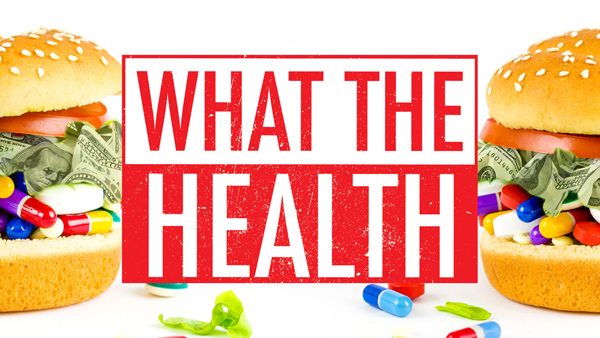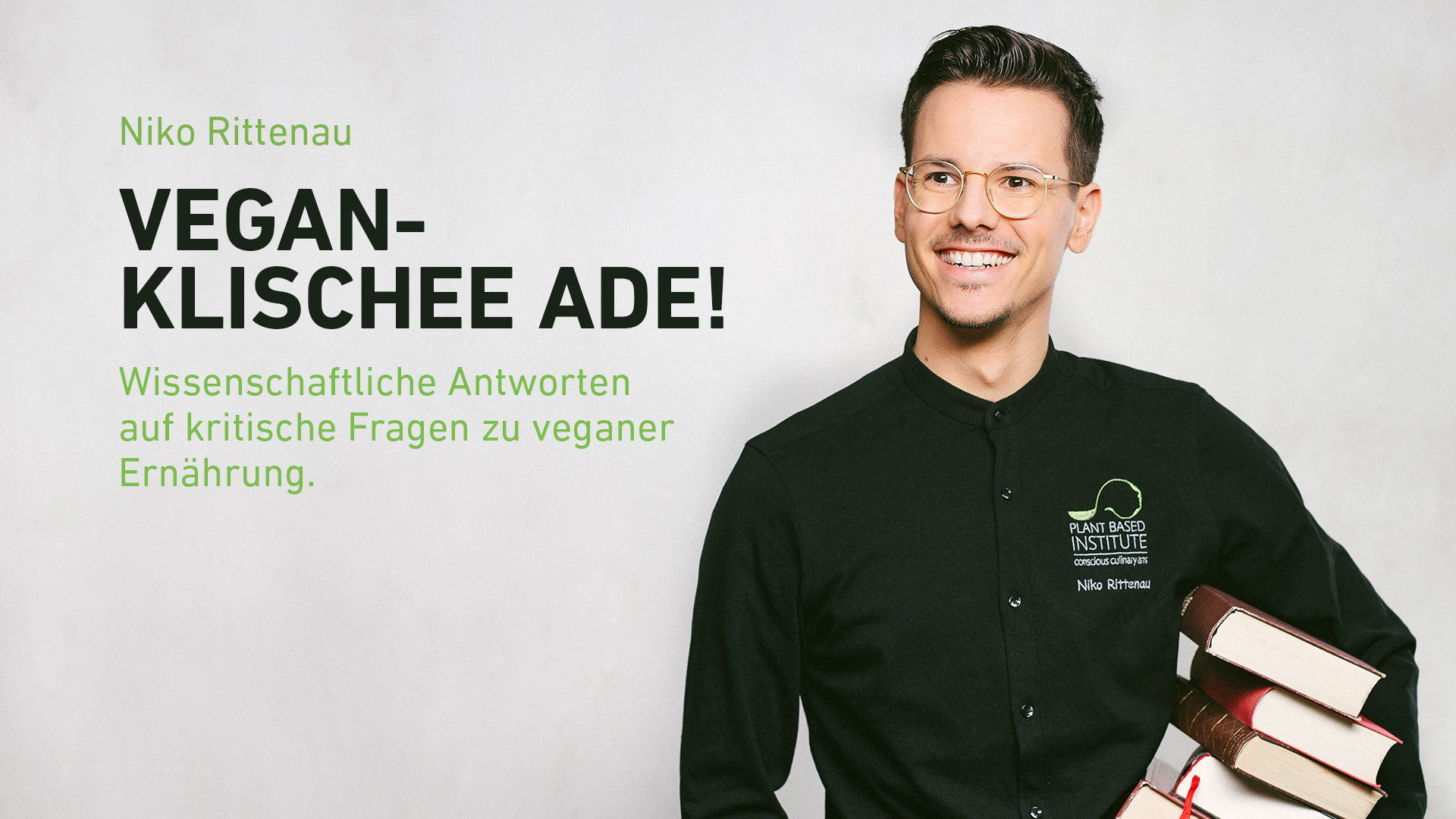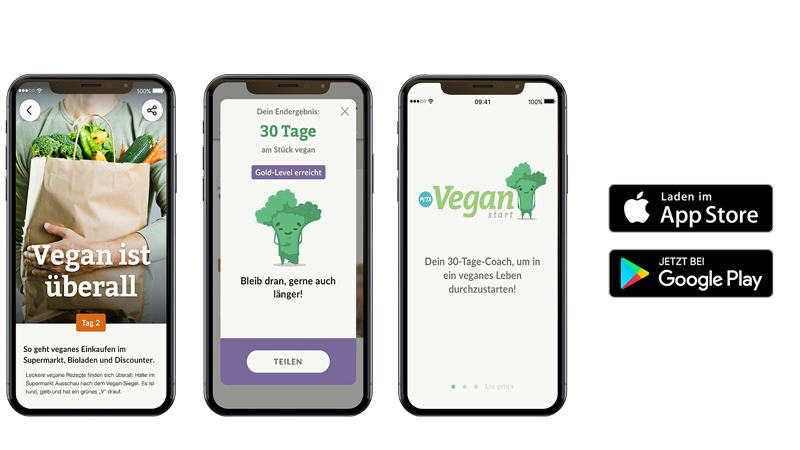Pflanzliche Ernährung
Um im Meinungs- und Ratschlags-Dschungel zurecht zu kommen, macht es Sinn, sich an einfachen, wissenschaftlichen Fakten zu orientieren, die den Mythos „vegan ist ungesund“ schnell zu Fall bringen. Die großen internationalen Ernährungsgesellschaften haben in ihren Positionspapieren aufgenommen, dass eine gut geplante vegane Ernährung nicht nur gesundheitlich machbar, sondern darüber hinaus auch sowohl in Prävention als auch teilweise in Therapie von ernährungsmitbedingten Krankheiten (Zivilisationskrankheiten) eingesetzt werden kann.
Nährstoffverfügbarkeit
Es gibt keinen Nährstoff, der sich ausschließlich in Tieren befindet. Sämtliche Nährstoffe stammen aus Pflanzen und können auch von uns direkt, ohne den Umweg über das Tier, aufgenommen werden. Allein Vitamin B 12 sollte zwingend supplementiert werden. Den Tieren in der Mast wird neben weiteren Mineralstoffen und Vitaminen ebenfalls Vitamin B 12 oder der Ausgangsstoff Cobalt supplementiert.
Ungesundes vermeiden
Indem wir tierische Produkte vermeiden, nehmen wir sehr wenig gesättigte Fette, kein Cholesterin (das wir selbst herstellen), keine Transfette (bei Vermeidung gehärteter Fette), keine entzündungsförderliche Arachidonsäure, keine gichtfördernden Purine, keine Antibiotika-
Proteine? Kein Problem.
Bei einer rein pflanzlichen, vollwertigen Ernährung nehmen wir vor allem komplexe Kohlenhydrate, absolut ausreichend Proteine, vor allem einfach und mehrfach ungesättigte Fettsäuren, einen höheren Gehalt an Mikronährstoffen (Vitamine, Mineralstoffe), Ballaststoffe und sekundäre Pflanzenstoffe und Antioxidantien zu uns.
Dokus

The Game Changers
Der Dokumentarfilm handelt von Top-Athleten, die sich bewusst dazu entschieden haben, sich ausschließlich vegan zu ernähren. Mit diesem Schritt handeln sie entgegen der gängigen Meinung, dass der Konsum von Fleisch ausschlaggebend für den Erfolg von Hochleistungssportlern ist. Die Doku ist in Englisch – es gibt jedoch u. a. deutsche Untertitel.

What the Health
Die Doku beschäftigt sich mit den unterschiedlichen Faktoren, die für Zivilisationskrankheiten wie Bluthochdruck, Übergewicht, Krebs oder Diabetes verantwortlich sind und was man gegen die Erkrankungen unternehmen kann. Der Filmemacher konfrontiert Vertreter der großen Konzerne, Gesundheitsorganisationen und Pharmaindustrie mit unbequemen Fragen.

Vegan-Klischee ade
Niko Rittenau ist einer der gefragtesten Experten in Deutschland, wenn es um die Themen Ernährung und Nachhaltigkeit geht. In diesem Vortrag räumt er mit den häufigsten Vorurteilen gegenüber der veganen Ernährung auf. Wissenschaftlich fundiert, aber allgemein verständlich, beantwortet er wichtige Fragen zur Versorgung mit essenziellen Nährstoffen wie Protein, Eisen, Calcium und Omega 3.
Multiresistente Keime
Aufgrund der Haltungsbedingungen werden die züchtungsbedingt sehr krankheitsanfälligen Tiere notwendigerweise immer wieder mit Antibiotika behandelt. Dies betrifft am meisten die Geflügelmast. Aufgrund von Resistenzen kommen bereits Reserveantibiotika zum Einsatz. Damit verringert sich auch die Palette der uns zur Verfügung stehenden Antibiotika. Weitere Folgen dieser Haltung sind multiresistente Keime.
Übertragung von Viren
Durch den Kontakt von Menschen und Tieren (über Futtermittel, Wildtiermärkte) kommt es zudem zur Übertragung von Viren. Auf diese Art sind bereits auch für den Menschen gefährliche Krankheiten entstanden. Diese speziesübergreifenden Krankheiten (Zoonosen) stellen uns, unser Gesundheitssystem und unsere Wirtschaft vor massive Probleme. Beispiele für diese Erkrankrungen sind Masern, Pocken, Keuchhusten, Typhus Grippe, Lepra, Tuberkulose, sowie wahrscheinlich COVID-19.
Einschätzung der WHO
2004 haben WHO (World Health Organization), FAO (Food and Agriculture Organization of the United Nations) und OIE (World Organisation for Animal Health) eine gemeinsame Erklärung veröffentlicht, nach der die Ursachen zoonotischer Krankheiten vor allem auf die steigende Nachfrage nach tierischem Protein und den damit verbundenen intensiven Tierhhaltungssystemen zurückzuführen ist. Es wird erwartet, dass in Zukunft immer mehr Seuchen aufkommenden werden.
eBook
Kritische Nährstoffe
Hier erfährst du, welche Funktionen die einzelnen Nährstoffe in unserem Körper haben und in welchen pflanzlichen Lebensmitteln sie zu finden sind. (Diese Informationen wurden von Sabine Gräfe, zertifizierte Vegane Ernährungsberaterin geprüft – bei Fragen zu deiner Gesundheit und Ernährung wende dich bitte an deinen Arzt oder deine Ärztin.)
Proteine
Proteine oder Eiweiße bestehen aus Aminosäuren. Von den ca. 320 bekannten Aminosäuren können 21 zur Bildung von Proteinen benutzt werden. Und nur 9 davon müssen wir tatsächlich mit der Nahrung aufnehmen. Die zugeführten Proteine werden in der Verdauung wieder zu Aminosäuren zerlegt und neu zu körpereigenen Proteinen zusammengefügt.
Proteine
mehr erfahren
Gute Proteinlieferanten: Hülsenfrüchte (reich an Lysin), Getreide (reich an Methionin), Pseudogetreide (Amaranth, Quinoa), Nüsse (Mandeln, Walnüsse), Samen, Sprossen, grünes Blattgemüse, Brokkoli, Avocado, Karotten, Tomaten
Tipp: Bei der Zufuhr der Proteine sollten sich hinsichtlich des Aminosäureprofiles gegenseitig ergänzende Lebensmittel kombiniert werden. Das sind z. B. Hülsenfrüchte mit Getreide. Dies kann im Laufe des Tages passieren und muss nicht in einer Mahlzeit erfolgen. Eine vollständige Abdeckung aller essentiellen Aminosäuren mit einer Ebenbürtigkeit zu Eiern und Milch liefern für sich alleine Soja, Quinoa, Buchweizen, Chiasamen, Hanf, Spirulina.
Kohlenhydrate
Kohlenhydrate sind Einfach- oder Mehrfachzucker. Es gibt sie in unterschiedlichen Formen. Sie werden von Pflanzen durch Photosynthese hergestellt, aber auch unser Körper ist in Zeiten fehlender Zufuhr in der Lage, Glukose selbst herzustellen. Dies geht über das Ausleeren der entsprechenden Speicher bis hin zur Nutzung anderer Makronährstoffe, die dann ihre eigentliche Aufgabe nicht mehr wahrnehmen können. Es macht also Sinn, dem Körper regelmäßig seinen „Treibstoff“ zuzuführen.
Proteine
mehr erfahren
Hauptfunktion: Lieferung von Energie.
Gute Kohlenhydratlieferanten: Kartoffeln, Getreide, Pseudogetreide (Quinoa, Amaranth, Hirse), Hülsenfrüchte
Tipp: Am günstigsten sind die Mehrfachzucker, die in unserem Verdauungstrakt nur nach und nach aufgespalten werden können. Diese kommen in den Pflanzen als Stärke vor. Ungünstig sind raffinierte Zucker z. B. in Form von Haushaltszucker, der sehr leicht aufgenommen werden kann und so den Blutzuckerspiegel rasch ansteigen lässt.
Fette
Fette bestehen aus Fettsäuren mit unterschiedlich langen Kohlenstoffketten. Wir können den Großteil der unterschiedlichen Fettsäuren, wie auch Cholesterin, selbst herstellen. Eine zusätzliche Zufuhr dieser Fette wirkt sich wenig förderlich bis ungünstig für unsere Gesundheit aus. Nicht selbst herstellen können wir mehrfach ungesättigte Fettsäuren wie Omega 3 und Omega 6.
Proteine
mehr erfahren
Hauptfunktion: Lieferung und Speicherung von Energie, Baustoff in Zellwänden, Produktion von Hormonen
Gute Fettlieferanten: Ölsaaten/-samen (Leinsamen, Chiasamen, Hanfsamen), Avocados, Nüsse, Pflanzenöl (sparsam), angereichertes Mikroalgenöl (DHA/EPA)
Tipp: Die tägliche Zufuhr sollte nur 30 % der Nahrungsenergie ausmachen. Dabei sollte der Schwerpunkt auf einfach und mehrfach ungesättigten Fettsäuren (Omega 3, DHA/EPA) liegen. Außerdem sollten verarbeitete/gehärtete Fette gemieden werden.
Eisen
Eisen ist ein Mineralstoff, der in verschiedenen Formen vorkommt und weltweit der größte Mangelnährstoff ist. In tierischen Organismen kommt er als Häm-Eisen vor. Aufgrund seiner Struktur ist es leichter aufnehmbar, was jedoch nicht bedeutet, dass es damit auch gesünder ist. Eine hohe Zufuhr von Häm-Eisen steht im Zusammenhang mit Herz-Kreislauf-Erkrankungen, Diabetes und Krebs. In Pflanzen liegt es als Nicht-Häm-Eisen vor. Es gibt sowohl Stoffe, die die Aufnahme erschweren als auch Stoffe, die die Aufnahme deutlich fördern. Ein wesentlicher Faktor ist hierbei der Eisenstatus.
Proteine
mehr erfahren
Hauptfunktion: Transport von Sauerstoff im Blut, wichtige Rolle für Immunabwehr und Gehirnfunktion
Gute Eisenlieferanten: Hülsenfrüchte ((Soja-)Bohnen, Linsen, Kichererbsen), Nüsse (Pistazien, Mandeln, Haselnüsse), Ölsaaten (Sesam, Kürbiskerne, Hanf, Leinsamen, Kakao), Vollkorngetreide (Haferflocken, Dinkel), Pseudogetreide (Hirse, Amaranth, Quinoa), Gemüse (Grünkohl, Rucola, Feldsalat, Zucchini), Trockenfrüchte (Aprikosen, Pfirsiche, Datteln)
Tipp: Kaffee/Tee nicht zu den Mahlzeiten trinken, dem Essen Vitamin C zufügen für eine bessere Aufahme.
Kalzium
Kalzium ist der mengenmäßig bedeutendste Mineralstoff im menschlichen Körper. Er ist ein Grundbaustein von Knochen und Zähnen. Die meisten Menschen halten Kuhmilch als unverzichtbaren Lieferanten von Kalzium. Allerdings ist 3/4 der Weltbevölkerung nach dem Abstillen laktoseintolerant. Die Rolle von Kuhmilch ist also völlig untergeordnet. Kalzium kommt über das pflanzliche Futter in die Tiere und wir können es ebenfalls sehr gut aus Pflanzen zu uns nehmen. Das Kalzium in Pflanzen ist vielfach gleichwertig, in vielen Pflanzen teilweise doppelt so stark wie in Kuhmilch bioverfügbar enthalten. Wie auch bei Eisen gibt es einige Stoffe, die die Aufnahme hemmen oder fördern.
Proteine
mehr erfahren
Hauptfunktion: Baustoff für Knochen und Zähne, Blutgerinnung, Muskelkontraktion, Reizübertragung im Nervensystem
Gute Kalziumlieferanten: dunkelgrünes Blattgemüse (Brokkoli, Grünkohl, Pak Choi, Rucola), Wildkräuter (Löwenzahn, Brennnesseln), Hülsenfrüchte (Kichererbsen, Soja), Trockenfrüchte (Feigen, Datteln), Samen (Sesam, Chia, Hanf, Mohn), Nüsse (Mandeln, Paranüsse), Pseudogetreide, Mineralwasser (> 400 mg/l)
Tipp: Kaffee/Tee nicht zu den Mahlzeiten trinken, dem Essen Vitamin C zufügen, Kalciumzufuhr über mehrere Mahlzeiten verteilen.
Vitamin B12
Vitamin B12 wird weder von Pflanzen noch von Tieren, sondern von Mikroorganismen gebildet. In Pflanzen kommt es nicht in nennenswerter Menge vor, bei Tieren in größeren Mengen in den Innereien, vor allem in der Leber. Da Innereien selten auf dem Speiseplan stehen und die Aufnahme von Vitamin B12 durch verschiedene Faktoren gestört sein kann, ist ein Mangel nicht so selten, wie angenommen und keinesfalls auf Veganer*innen begrenzt. Der Körper kann Vitamin B12 für einen gewissen Zeitraum (ca. 3 – 5 Jahre) speichern. Ein Mangel kann zu irreversiblen Schädigungen (z. B. Blutarmut, neurologische Störungen) führen.
Proteine
mehr erfahren
Hauptfunktion: DNA-Synthese, Zellteilung, Blutbildung, Gehirn- und Nervenfunktionen, bestimmte Abbauprozesse (Entgiftungen)
Gute Vitamin B12-Lieferanten: Supplemente, angereicherte Lebensmittelprodukte, Algen oder Zahnpasta können unterstützen
Tipp: Status regelmäßig (jährlich) durch geeignete Bluttests (Holo-TC) prüfen. Synthetische Formen wie Cyanocobalamin werden vom Körper genauso gut verarbeitet, wie die natürlichen und aktiven Formen. Bei gestörter Aufnahme kann die Aufnahme in Form von Lutschtabletten hilfreich sein.
Vitamin D
Vitamin D produzieren wir vorrangig selbst. In unseren Breitengraden (meist zu wenig UVB-Strahlung) und bei unserem Lebensstil (Haut durch Kleidung bedeckt, verstärkter Aufenthalt in Räumen) reicht die Eigensynthese jedoch oft nicht aus, weshalb Vitamin D ein kritischer Nährstoff für die Gesamtbevölkerung ist. Über die Nahrung könnte er über eine tägliche Portion Lebertran oder fetten Seefisch gedeckt werden, was jedoch unrealistisch ist.
Proteine
mehr erfahren
Hauptfunktion: Knochengesundheit, Kalziumstoffwechsel, Immunabwehr, Krebsprävention, Muskelfunktionen
Gute Vitamin D-Lieferanten: Eigensynthese bei idealen Umständen, Supplemente, angereicherte Lebensmittel können unterstützen
Tipp: Inzwischen gibt es bioaktives Vitamin D 3 auch aus Pflanzen (Flechten).
Ballaststoffe
Ballaststoffe sind unverdauliche Mehrfachzucker in den Zellwänden der Pflanzen. Sie haben zwar keinen Nährwert, u. a. binden sie jedoch Fremd-/Giftstoffe, verbessern die Darmgesundheit, sorgen für Sättigung und einen konstanteren Blutzuckerspiegel. 3/4 der deutschen Bevölkerung erreicht die empfohlene Aufnahmemenge nicht. Veganer liegen in der Regel sogar deutlich über der Mindestempfehlung.
Proteine
mehr erfahren
Gute Ballaststoff-Lieferanten: Obst, getrocknete Früchte, Gemüse,Vollkornprodukte, Nüsse, Samen und Hülsenfrüchte
Sekundäre Pflanzenstoffe
Sekundäre Pflanzenstoffe sind Abwehr-, Farb- und Duftstoffe der Pflanzen. Sie können auch beim Menschen wichtige Funktionen erfüllen: Steigerung der Abwehrkräfte, Schutz vor Infektionen mit Pilzen, Bakterien oder Viren, Senkung des Cholesterinspiegels, Senkung von Blutzucker und Blutdruck und Vermeidung von Gefäßverstopfungen und sogar Vorbeugung von Krebs.
Proteine
mehr erfahren
Gute sekundäre Pflanzenstoffe-Lieferanten: Gemüse, Obst, Kartoffeln, Hülsenfrüchte, Nüssen sowie Vollkornprodukte
Apps
Eisenhaltige Lebensmittel
Grafik: Eisengehalt ausgewählter pflanzlicher Lebensmittel pro 100 Gramm. Am Tag benötigt ein durchschnittlicher Erwachsener etwa 10 bis 15 mg Eisen, Schwangere bis zu 30 mg und Kinder mindestens 10 mg .
- Kürbiskerne – 12,5 mg
- Sesam – 10 mg
- Haferflocken – 5,8 mg
- Tofu – 3,7 mg
Kalziumhaltige Lebensmittel
Grafik: Kalziumgehalt ausgewählter pflanzlicher Lebensmittel pro 100 Gramm. Pro Tag benötigt ein durchschnittlicher Erwachsener etwa 1000 mg Kalzium, Kleinkinder ab 600 mg und Jugendliche bis 1200 mg.
- Sesamsamen – 783 mg
- Kalziumreiches Mineralwasser (1 L) – 500 mg
- Mandeln – 252 mg
- Pflanzenmilch mit Kalzium – 120 mg
Proteinhaltige Lebensmittel
Grafik: Proteingehalt ausgewählter pflanzlicher Lebensmittel pro 100 Gramm. Pro Kilogramm Körpergewicht benötigen wir etwa 0,9 g Protein. Bei einem Gewicht von 65 kg sind das pro Tag ca. 58 g und bei 85 kg ca. 76 g.
- Kürbiskerne – 35 g
- Erdnüsse – 25 g
- Seitan (zubereitet) – 18 mg
- Sojaschnetzel – 16 g
Quelle:
Niko Rittenau (2018), Vegan-Klischee ade! Wissenschaftliche Antworten auf kritische Fragen zu veganer Ernährung (2. Auflage), Ventil Verlag UG
zum Buch

